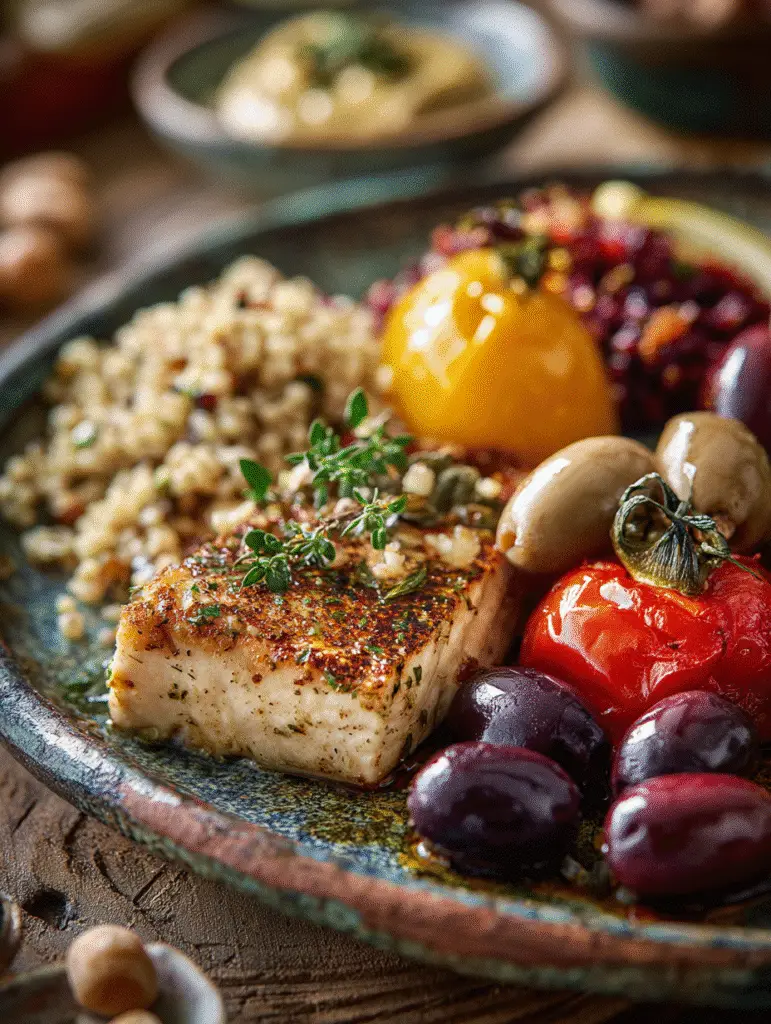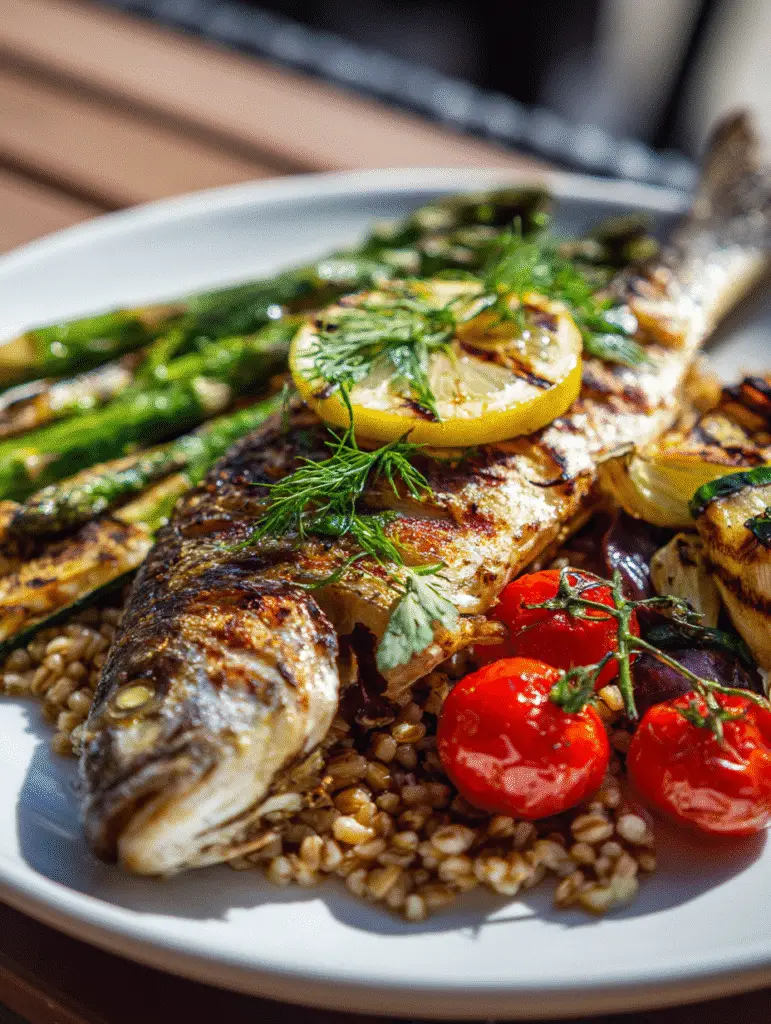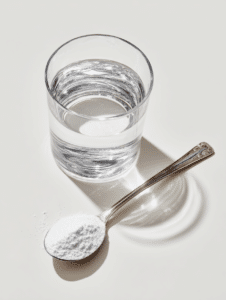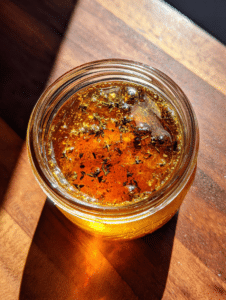Disclaimer: This content is for educational purposes only, not medical advice. Always consult with a doctor before making significant changes to your diet, especially if you have pre-existing health conditions.

What is The Mediterranean Diet: A Simple Way of Eating That Changed My Life
I first stumbled across the Mediterranean diet after a summer trip to coastal Italy in my twenties. I remember sitting in a tiny courtyard café, sipping olive oil-drizzled tomato soup with fresh herbs, crusty bread, and a glass of red wine. No calorie counting. No measuring. Just slow, joyful eating. When I came home, I started learning what the Mediterranean diet actually is, and how it could fit into real-life, weeknight dinners for a busy home cook like me.
In this guide, we’ll break down exactly what the Mediterranean diet is, what it includes (and doesn’t), real meal ideas, a printable food list, and how it fits into everyday life.
In this Article
Key Takeaways: What You Need to Know
- The Mediterranean diet is based on traditional eating patterns from countries like Greece, Italy, and Spain.
- It emphasizes whole foods like vegetables, fruits, olive oil, legumes, nuts, seafood, and whole grains.
- You’ll avoid processed foods, added sugars, and excess red meat, not by restriction, but by replacement.
- It’s not just a diet, it’s a lifestyle that promotes joyful, balanced, anti-inflammatory eating.
- Studies show it supports heart health, longevity, and gut health.
- No calorie counting, just mindful choices, simple meals, and good company.
- Start here with our Mediterranean Diet Guide or grab our free printable food list.
What Is the Mediterranean Diet, Really?
What does the Mediterranean diet consist of?
The Mediterranean diet consists of daily meals built around plant-based foods, healthy fats, and lean proteins, with an emphasis on seasonal and regional ingredients. Think roasted veggies with olive oil, lentil stews, grilled fish, and a glass of red wine enjoyed with friends. It’s less about what you cut out and more about what you put in.
At its core, here’s what the Mediterranean diet includes:
| Eat Often | Eat Occasionally | Avoid or Minimize |
|---|---|---|
| Vegetables & Fruits | Poultry, Eggs, Dairy | Processed foods & refined carbs |
| Whole Grains & Legumes | Red Wine (moderation) | Sugary beverages |
| Olive Oil & Nuts | Red Meat (limit) | Saturated & trans fats |
| Fish & Seafood | Artificial sweeteners | |
| Herbs & Spices | Fast food |
It’s a flexible eating pattern rooted in flavor, balance, and simplicity, not rigid rules.
Want a quick cheat sheet? Download our Mediterranean Diet Food List to keep it on your fridge.
How does the Mediterranean diet work in real life?
In my kitchen, it looks like this:
- Breakfast might be Greek yogurt with berries, chia seeds, and a drizzle of honey.
- Lunch is often a chickpea salad with olive oil, herbs, and fresh tomatoes.
- Dinner might be baked salmon with roasted eggplant, couscous, and lemon.
You’ll find that many Mediterranean-style meals use fewer ingredients but deliver big on flavor. It’s less time spent cooking, and more time spent enjoying. And when I follow it, I sleep better, feel lighter, and snack less.
It’s a sustainable way to eat that doesn’t leave you feeling deprived, just nourished.
Want inspiration? I’ve built a full Mediterranean Diet Meal Plan to make it even easier to start.
What Do You Eat in a Mediterranean Diet?
What are the foods that can be eaten in a Mediterranean diet?
You eat whole, natural, colorful foods, mostly from plants, with seafood and good fats playing a big supporting role. No gimmicks. No powders. Just real ingredients that your great-grandma would recognize.
Here’s a look at the foods you’ll keep in heavy rotation:
Mediterranean Diet Staples
| Category | Examples |
|---|---|
| Vegetables | Spinach, kale, zucchini, tomatoes, eggplant, onions, bell peppers |
| Fruits | Oranges, grapes, figs, apples, berries, melons |
| Legumes | Chickpeas, lentils, white beans, black beans |
| Whole Grains | Farro, bulgur, brown rice, barley, whole wheat bread |
| Seafood | Salmon, sardines, anchovies, shrimp, cod |
| Dairy (moderate) | Greek yogurt, feta, ricotta, hard cheeses like Parmigiano |
| Healthy Fats | Extra virgin olive oil, olives, walnuts, almonds |
| Herbs & Spices | Basil, oregano, garlic, parsley, mint, turmeric |
You’ll find loads of inspiration on our Mediterranean Diet Recipes page, each one tested in my Texas kitchen, weeknight approved.
What foods are not allowed on the Mediterranean diet?
While there’s nothing strictly forbidden, there are certain foods you’ll want to limit or avoid, simply because they don’t align with the Mediterranean way of eating. It’s more about swapping than banning.
Skip or reduce:
- Sugary cereals and pastries
- Soda and sweetened drinks
- White bread, white pasta
- Processed meats like bacon or sausage
- Fried foods and fast food
- Hydrogenated oils and margarine
- Packaged snacks with a mile-long ingredients list
Instead of feeling restricted, I think of it like this: why eat something that leaves me sluggish when I can have something fresh that leaves me glowing?
It’s easy to fall into a rhythm when your fridge is stocked with fresh ingredients and you have this food list handy.
What Is a Mediterranean Diet Meal Plan?
What is an example of a Mediterranean diet meal plan?
A Mediterranean diet meal plan doesn’t require fancy ingredients or hours in the kitchen. It’s practical, fresh, and flexible. Whether you’re cooking for yourself or for four hungry kids (hi, fellow parents!), it can easily be tailored to your lifestyle.
Here’s a one-day sample meal plan that’s simple, satisfying, and true to the Mediterranean style:
One-Day Mediterranean Meal Plan
| Meal | What to Eat |
|---|---|
| Breakfast | Greek yogurt topped with blueberries, walnuts, and a drizzle of raw honey |
| Mid-Morning | A handful of almonds + one small apple |
| Lunch | Lentil salad with cucumbers, cherry tomatoes, feta, and olive oil + whole grain pita |
| Afternoon | Hummus with sliced red bell pepper and carrots |
| Dinner | Grilled salmon with lemon and herbs, quinoa with parsley, and sautéed spinach |
| Dessert | Fresh figs or a few squares of dark chocolate |
You’ll notice each meal is centered around whole ingredients with a focus on flavor. That’s the magic of this way of eating: it’s deeply satisfying, yet gentle on your system.
Looking for a full 7-day version? I created this Mediterranean Diet Meal Plan with grocery lists, prep tips, and make-ahead ideas. It’s built for busy people and real schedules.
Can the Mediterranean diet work for families or picky eaters?
Absolutely. I’ve adapted this plan for my two kids (and a very Texan husband who once called hummus “cold bean dip”). Here’s how we make it work:
- Make it customizable. Lay out build-your-own options: couscous bowls with toppings, or taco-style wraps with grilled veggies and fish.
- Simplify snacks. My kids love sliced cucumbers with olive oil and lemon or a little cheese with whole grain crackers.
- Start with familiar meals. Swap white pasta for whole grain. Use olive oil instead of butter. Small changes lead to big habits.
And yes, sometimes we still do Friday night pizza. We just top it with kalamata olives, artichokes, and fresh basil.
The Mediterranean way is about balance, not perfection, which makes it family-friendly by default.

Top 10 Foods in the Mediterranean Diet
What are the top 10 foods in the Mediterranean diet?
These aren’t just trendy ingredients. These are the workhorses of Mediterranean cooking, the foods that make 10-minute lunches, cozy one-pot dinners, and flavor-packed snacks easy and nourishing.
Here are the 10 staples you’ll see again and again:
The Mediterranean Top 10
| Food | Why It Matters | How I Use It |
|---|---|---|
| Olive Oil | Heart-healthy fat, anti-inflammatory | Drizzle on everything, salads, toast, roasted veggies |
| Tomatoes | Rich in lycopene, easy to cook with | Canned or fresh, use in sauces, soups, stews |
| Chickpeas | Plant protein + fiber | Blend into hummus or toss into grain bowls |
| Spinach | Nutrient-packed leafy green | Wilt into eggs, pasta, or sautéed with garlic |
| Salmon or Sardines | Omega-3-rich seafood | Roast or pan-sear with lemon + herbs |
| Greek Yogurt | High in protein + probiotics | Swirl with honey and berries, or use in sauces |
| Whole Grains | Steady energy + fiber | Cook big batches of farro, bulgur, or brown rice |
| Garlic | Flavor booster + natural antibiotic | Mince fresh or use roasted for mellow sweetness |
| Feta Cheese | Tangy flavor in small doses | Crumble on salads, pastas, or grain bowls |
| Herbs (Fresh & Dried) | Anti-inflammatory + flavor packed | Oregano, basil, parsley, always on my windowsill |
These foods are the foundation of many of my Mediterranean recipes, and they’re all budget-friendly, widely available, and quick to prep.
Real-life testimonial: “It changed how I shop and cook.”
When I first introduced the Mediterranean diet to my friend Jamie (a busy mom of three, and self-proclaimed “non-cook”), she was skeptical. But after one week of building meals around these core foods, she said:
“I’ve never felt so full and light at the same time. I didn’t even miss the sugar cravings because I was actually satisfied. I cook once, and we eat twice, it’s working for all of us.”
Her favorite? My quick white bean and spinach stew. It’s become her go-to “I’m too tired to cook” dinner.
This way of eating isn’t a trend. It’s sustainable, satisfying, and soul-soothing, even if you’ve got five minutes and a hungry crew.
Pros and Cons of the Mediterranean Diet
What are the pros and cons of the Mediterranean diet?
The Mediterranean diet is often praised as the gold standard of healthy eating, and for good reason. But like any approach, it’s not perfect for everyone. Let’s break it down.
Pros of the Mediterranean Diet
| Benefit | Why It Matters |
|---|---|
| Heart Health | Numerous studies link it to reduced heart disease and stroke risk [NIH Study]. |
| Anti-Inflammatory | Rich in omega-3s, antioxidants, and fiber, reduces chronic inflammation. |
| Weight-Friendly | It’s not a “diet” in the restrictive sense, making it easier to maintain. |
| Brain Health | Linked to lower risk of cognitive decline and Alzheimer’s [Mayo Clinic]. |
| Gut-Friendly | High in prebiotic fiber (hello, legumes and greens) which supports healthy digestion. |
| Flexible and Sustainable | No counting. No cutting out entire food groups. Just better choices. |
For many, it’s a lifelong approach to wellness, not a 30-day fix. That’s a big reason why it’s recommended by Harvard’s School of Public Health [Harvard Nutrition Source] and the USDA’s Dietary Guidelines [USDA.gov].
Cons (and how to work with them)
| Potential Challenge | How to Navigate It |
|---|---|
| Meal Prep Can Take Time | Batch cook grains, roast veggies in bulk, and prep dressings in jars. |
| Fresh Ingredients = $$$ | Buy frozen seafood, canned beans, and in-season produce for budget-friendliness. |
| Not Vegetarian by Default | While seafood is emphasized, it’s easy to adapt with plant-based proteins. |
| Wine Isn’t for Everyone | Skip it if it doesn’t suit your health, beliefs, or preferences. |
And let’s be real, if you’re used to takeout or ultra-processed snacks, this will take some adjustment. But once your taste buds recalibrate? You’ll crave olive oil and tomatoes more than chips.
Does science support the Mediterranean diet?
Yes, over and over again.
- A landmark study published in The New England Journal of Medicine showed that people on the Mediterranean diet had a 30% lower risk of cardiovascular events compared to a low-fat diet group [NEJM].
- It’s been shown to support weight loss, reduce insulin resistance, and even lower markers of depression [Cleveland Clinic].
It’s recognized by:
- World Health Organization (WHO)
- American Heart Association (AHA)
- U.S. News & World Report, where it’s ranked the #1 Best Diet Overall since 2018
For deeper reading, the Wikipedia entry on the Mediterranean diet offers a well-researched overview of its origins and health implications.
How to Start the Mediterranean Diet for Beginners
How do you start the Mediterranean diet step-by-step?
Start where you are. You don’t need a passport to Greece or an organic grocery budget to make this work. You just need a few shifts in how you stock your kitchen and build your plate.
Here’s the same 4-step method I use with friends, readers, and even my own family:
Step 1: Stock the Right Staples
Build your Mediterranean pantry gradually with budget-friendly basics:
- Olive oil (extra virgin)
- Canned beans (chickpeas, lentils)
- Whole grains (farro, brown rice, whole wheat pasta)
- Tomatoes (canned, fresh, sun-dried)
- Spices (oregano, cumin, garlic powder, paprika)
- Frozen veggies or greens
- Canned tuna or sardines
Don’t try to change everything in one grocery run. Just swap things out as you run out.
Step 2: Follow the “Mediterranean Plate” Rule
When building a meal, think in this ratio:
- 50% vegetables
- 25% whole grains or legumes
- 25% lean protein (seafood, beans, or eggs)
- Drizzle of olive oil + herbs
Use our Mediterranean Diet Food List as a printable reference when shopping or meal planning.
Step 3: Make Easy Mediterranean Swaps
Here are some realistic, beginner-friendly swaps:
| Instead of… | Try This… |
|---|---|
| Butter or margarine | Extra virgin olive oil |
| White rice or pasta | Farro, bulgur, or whole grain pasta |
| Creamy salad dressings | Olive oil + lemon + garlic |
| Soda or sugary drinks | Sparkling water with citrus or herbs |
| Processed meats or hot dogs | Grilled chicken or lentils |
| Chips or crackers | Hummus + sliced cucumbers or bell peppers |
I promise: once you start drizzling roasted veggies with lemony olive oil, you’ll forget bottled ranch ever existed.
Step 4: Focus on the Experience, Not Just the Food
The Mediterranean lifestyle is about how you eat, not just what you eat.
- Eat slowly and at the table
- Cook simple meals and share them with others
- Embrace home cooking over perfection
- Walk more, stress less
This step is underrated, and it’s where a lot of the real health benefits show up.
Where can beginners get more help?
Start small with my free 7-Day Mediterranean Diet Meal Plan. It’s filled with recipes, prep tips, and make-ahead shortcuts that work even on your busiest weeks.
Need visual inspiration? The Mediterranean Diet Recipes page is constantly updated with simple, delicious meals from my kitchen in Texas.

Mediterranean Diet FAQs Answered Simply
What do you eat in a Mediterranean diet?
You eat mostly whole, plant-based foods like vegetables, fruits, legumes, whole grains, olive oil, nuts, and seeds. Seafood is eaten regularly, while dairy, eggs, and poultry are included in moderation. Red meat and processed foods are limited. Meals focus on fresh, seasonal ingredients with lots of herbs and simple prep.
Check out my Mediterranean food list to make shopping a breeze.
What is not allowed on a Mediterranean diet?
You avoid or minimize:
Added sugars (soda, desserts)
Processed snacks and frozen meals
Refined grains (white bread, white pasta)
Saturated fats like butter or margarine
Red and processed meats (bacon, sausage)
The Mediterranean diet isn’t restrictive, it simply replaces less healthy foods with whole, nourishing ones.
What is an example of a Mediterranean diet meal plan?
Here’s one example:
Breakfast: Greek yogurt with berries and walnuts
Lunch: Lentil salad with tomatoes, cucumber, olive oil
Dinner: Grilled salmon, quinoa, and sautéed spinach
Snacks: Hummus with veggies, a handful of almonds
Get the full 7-day meal plan here with grocery lists and prep tips.
What are the top 10 foods in the Mediterranean diet?
The top 10 Mediterranean foods include:
Olive oil
Tomatoes
Chickpeas
Spinach
Salmon or sardines
Greek yogurt
Whole grains (like farro, bulgur)
Garlic
Feta cheese
Fresh herbs
These ingredients appear in most Mediterranean recipes and make quick, healthy meals easy.
Final Thoughts: Why the Mediterranean Diet Works
The Mediterranean diet works because it’s not a diet. It’s a way of living that makes healthy eating natural, joyful, and sustainable. You eat in color. You enjoy your meals. You feel full, not just physically, but emotionally too.
From personal experience, I can say: it’s how I cook for my family, how I stay energized through busy weeks, and how I stay rooted in real food joy.



